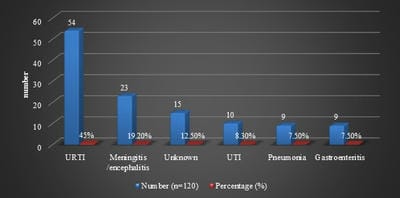Clinical profile and cerebrospinal fluid indices in children with complex febrile seizures
Suryavanshi A R.1, Bodhgire S B.2*, Anerao R D.3, Pawar S.4, Patil A T.5, Paranjape M.6
DOI: https://doi.org/10.17511/ijpr.2020.i06.10
1 Amol Ramrao Suryavanshi, Associate Professor, Department of Pediatrics, Government Medical College and Hospital, Aurangabad, Maharashtra, India.
2* Sachin Bapurao Bodhgire, Assistant Professor, Health Department, Government Medical College and Hospital, Aurangabad, Maharashtra, India.
3 Rahul Digambarrao Anerao, Incharge, Health Department, District Urban Leprosy, , Maharashtra, India.
4 Shilpa Pawar, Associate Professor, Department of Pediatrics, Government Medical College and Hospital, Aurangabad, Maharashtra, India.
5 Amit Tukaram Patil, Junior Resident, Department of Pediatrics, Government Medical College and Hospital, Aurangabad, Maharashtra, India.
6 Mugdha Paranjape, Junior Resident, Department of Pediatrics, Government Medical College and Hospital, Aurangabad, Maharashtra, India.
Introduction: Fever with seizure is the most common type of seizure occurring in children. A seizure is a common presentation for which a child may come to the emergency and may occur in up to 10% of children presenting to the emergency. Among all these seizures, Febrile seizures (FS) are the most common type of childhood seizures, affecting 2–5% of children older than 1 month and most commonly from 6 months–5 years old. Material and Methods: A hospital-based, prospective study conducted at the Department of Pediatrics, Government Medical College, and Hospital Aurangabad conducted from November 2018 to February 2020. Results: A total of 120 cases that presented with Complex Febrile Seizures (CFS) between six months to five years of age were included. Among them, 83 (69.1%) were male and 47 (30.9%) were female children. There were a total of 63 children in 6-12 months age, 32 in 12-24 months, and 25 in the above 12 months age group. Conclusion: In conclusion, it was found that age less than 1 year and male gender were the most significant risk factors for Complex Febrile Seizure in our area.
Keywords: Seizure, Fever, Epilepsy, Complex febrile seizure, clinical profile
| Corresponding Author | How to Cite this Article | To Browse |
|---|---|---|
| , Assistant Professor, Health Department, Government Medical College and Hospital, Aurangabad, Maharashtra, India. Email: |
Suryavanshi AR, Bodhgire SB, Anerao RD, Pawar S, Patil AT, Paranjape M. Clinical profile and cerebrospinal fluid indices in children with complex febrile seizures. Pediatric Rev Int J Pediatr Res. 2020;7(6):287-292. Available From https://pediatrics.medresearch.in/index.php/ijpr/article/view/617 |


 ©
© 